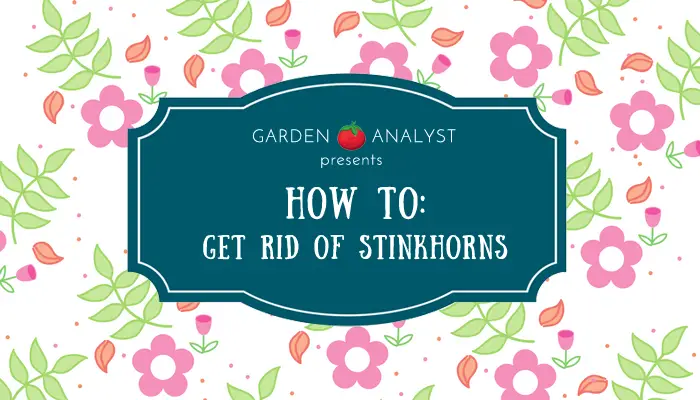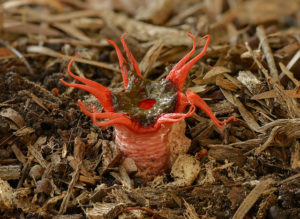Is your backyard producing a strange odor or smell? Do you see fungus growing around your feet? There may be stinkhorns about! Read on to learn about how to get rid of stinkhorns from your property.


How to Get Rid of Stinkhorns
Cold and moist weather occurring in summer, during several weeks a year, brings something odd and unpleasant to landscapes, backyards, and gardens. A putrid, rotting smell starts spreading all over, an odor so atrocious that you can’t even open your window.
The distinct smell actually comes from a fungus called Stinkhorn – a fungus with a straight phallus-like stem, found in many western parts of North America. Due to the obscene shape, Victorian people were disgusted and ashamed at the shape of this fungus. With no knowledge about benefits of this mushroom, they considered it ignominious, so killing the fungus with cudgels was a part of the ritual.
Stinkhorn is certainly unpleasant both for the eye and the nose, so it’s not a surprise that almost everyone tries to get rid of it. But, how to do that? Is there maybe a reason why just it shouldn’t be removed from your backyard? Here are some insights which may help you to make a final decision.
What Are Stinkhorns?
Stinkhorns are saprophyte fungi of Phallaceaefamily. Phallaceae family includes many fungi that appear in various body shapes, sizes, and colors. Depending on the type, they can be star-shaped, globular and finger-like, and the colors vary from white to orange and pink. Some of them even have a ‘skirt’ – a white crochet-like membrane, covering the mushroom’s body.
There are several Stinkhorn species usually found in our landscapes:
- Phallus impudicus or Common Stinkhorn – phallus-like, tall and white stem with dark olive colored cap
- Phallus hadriani or Dune Stinkhorn – the top of the stem have a thimble-like cap with olive-colored spore slime
- Mutinus Caninus (Mutinus elegans) or Dog Stinkhorn – headless, single stalk orange to pink mushroom
- Aseroe rubra or Starfish Stinkhorn – red, star-shaped mushroom covered in brownish slime on a white stalk
All of them have something in common – they smell terribly atrocious. Stinkhorns’ caps are covered by a sticky, smelly substance called the gleba, borne on the end of a stalk known as receptaculum. Stinkhorns’ existence and reproduction actually depend on this foul smell – it attracts ants and flies which help Stinkhorns to spread their spores.
Although there is a great diversity in fungi shape, structure and color, all Stinkhorn mushrooms start out as egg-like oval structures. These golf ball-like eggs usually grow underground, but some of them are found peeking out of the soil. Mature receptaculum emerges from the egg and gives the mushroom its final shape.
They usually grow in colonies and they grow extremely rapidly – it seems they just suddenly pop-up. Their rapid growth can be observed with the naked eye – this mushroom can grow to 1 cm in just 5 minutes.
Stinkhorns, like all mushrooms, are saprophyte, meaning they are unable to produce their own food, so they need nutrients from the soil. Stinkhorns are usually associated with the rotten wood and they are found in the decomposing hardwood mulch – they breed on sawdust piles, dead roots, underground stumps, rotting timber and other high cellulose containing materials.
How to Control and Kill Stinkhorn Fungus?
The bad news is that there isn’t much what one can do. But, the one is they are not harmful to people and plants, and they are seasonal, occurring only for several weeks once or twice a year.
Nevertheless, if you can’t stand the smell, or their presence simply annoys you, there are some control and prevention measures that could keep them from coming back.
First of all – forget chemical treatment. There is no safe and effective chemical control that can be recommended. Home-made chemical treatments (like bleach in boiling water) can be unsafe for you, but they can also kill various of helpful bacteria and fungus present in the soil.
Instead, try cultural method – hand-picking.
Put on disposable protective gloves (the smell of Stinkhorns is difficult to remove from the skin) and try to collect all the grown fungi and underground eggs too. Put them in a zipper bag to avoid spore spreading and throw them away. Remove a certain amount of the soil around Stinkhorn, too. This way you will get rid of the remaining spores, inhibiting the further growth of these mushrooms.
Remove the underground part of mature mushrooms – not just the visible above-ground part – a much larger fungal mass (mycelium), full of spores, is actually growing beneath the surface.
Stinkhorns eggs can be found in the ground year-round, but most of the year they’re dormant. They start growing with the heavy rains during summer months.
Simply remove visible samples as they occur. It is easy, practical, and shown effective. You can locate them easily – just trust your nose and follow the smell.
Don’t water the area for a while. Mushrooms need a dump for flourishing. Keep your soil dry as much as you can.
Finally, consider the most effective method –environment alteration. Since Stinkhorn breed on mulch, try to remove their food source. Remove the mulch and all decaying organic material and consider replacing them with a live groundcovers, pine and cypress needles, straw etc.
Or, simply be patient – when sunny, dryer and warmer days arrive, Stinkhorns will no longer be appearing. The mushrooms will disappear when conditions no longer favor them.
How to Benefit from Stinkhorns?
If you can tolerate Stinkhorns’ smell, you should consider keeping them in your garden. Stinkhorns are decomposers – they break down the rotting organic material, creating a nutritively rich environment for the plants. When they break down the mulch, plants use that material for nourishment.
So, they are really beneficial organisms for the garden soil. If you can tolerate the smell, don’t remove them. They’ll disappear by themselves in a few weeks, and your soil will be enriched with various nutrients.
Believe it or not, not just the Stinkhorns are not poisonous, at the egg stage, they are even said to be edible. It is a usual meal in Asia; they are treated as a delicacy in Germany, and some civilizations have used these strange mushrooms as an aphrodisiac for centuries. Though it isn’t greatly valued as food, some of the bravest dare to eat it.
However, considering Stinkhorns’ non-harmful and beneficial nature, think twice before you decide to destroy them.